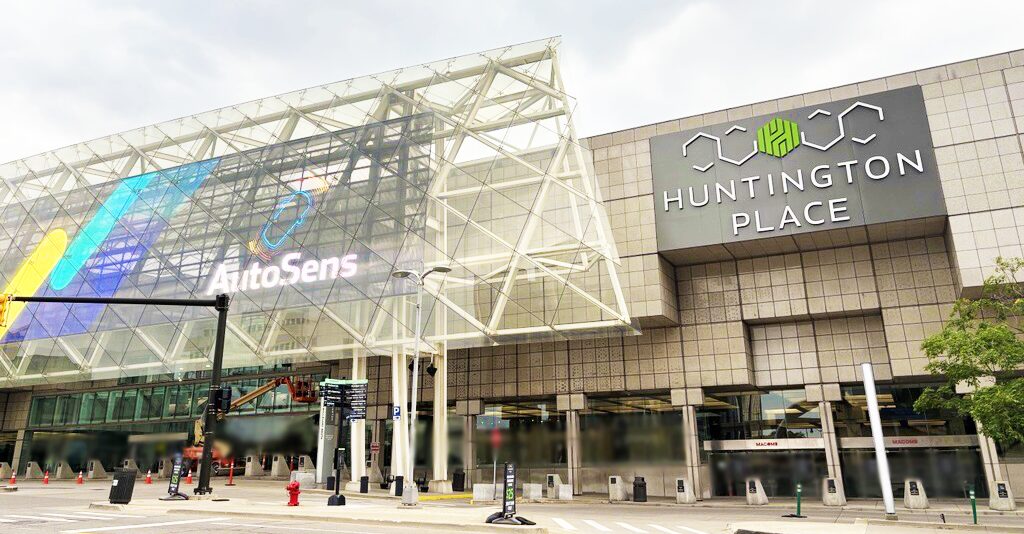
- Optical Products
Anti-reflection film using roll-to-roll sputtering technology
Contents
How anti-reflection film works
Anti-reflection film, also known as “AR film”, is designed to prevent glare by reducing the reflection of external light on display surfaces. It is commonly used in a variety of displays, including large TVs, PC monitors, car navigation systems, and instrument clusters. AR films typically feature a thin transparent layer with an optically anti-reflective effect on the surface of a base film.
To understand how AR films suppress light reflection, consider the shimmering surface of water. This shimmer is caused by light reflecting at the boundary surface due to the difference in refractive index between air and water. Similarly, the surface of a screen is in contact with air, so light will always be reflected, even if the screen is covered with a transparent glass cover. AR films are designed to minimize this reflection, or glare, as much as possible.

As depicted in the figure above, Dexerials AR film is composed of an adhesive layer, a base film, a hard coat layer, an anti-reflection (AR) layer, and an anti-smudge layer. Additionally, the AR layer consists of several layers with varying refractive indices. Dexerials manufactures this film with controlled refractive indices and layer thickness to minimize reflected light. The film also employs the principle of destructive interference between the boundary-reflected light waves and surface-reflected light waves.
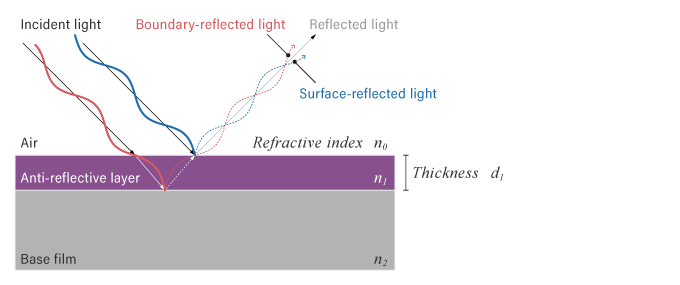
Manufacturing methods for anti-reflection films
There are two primary methods for manufacturing AR films: a wet method and a dry method. In the wet method, a liquid material is applied to the base film and dried to form an anti-reflection layer.
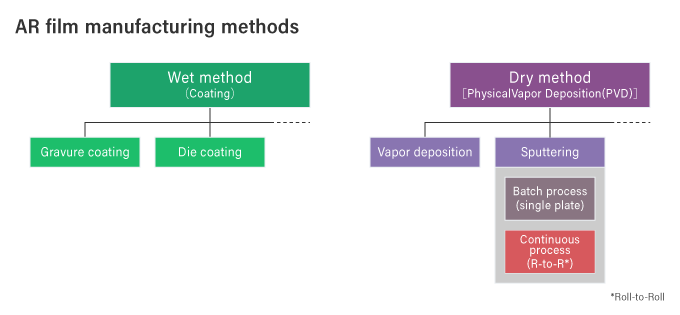
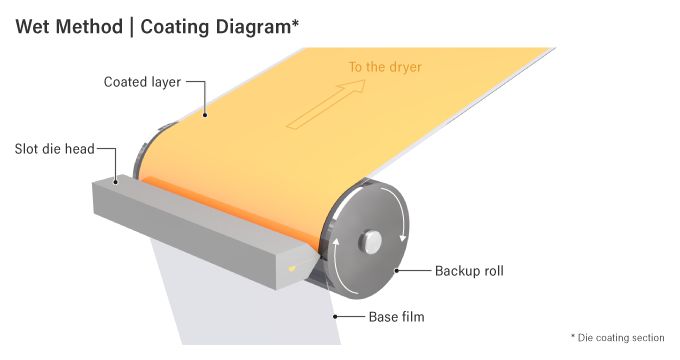
In contrast, Dexerials uses sputtering, a major technology of the dry-type method, to create a high-quality and accurate composition of optically thin layers. In sputtering, argon ions are ionized under high voltage and struck against a target material in a vacuum chamber. The particles repelled from the target material are deposited to form a thin layer on the substrate’s surface.

Adopting the roll-to-roll method
Dexerials’ AR films are manufactured using a roll-to-roll production system. This system, which involves the continuous feeding of material rolls into the production line for processing and rolling, ensures high-quality processing and outstanding production efficiency.
In the production of AR films, thin films with varying refractive indices are layered onto the base film to cater to different light wavelengths. Dexerials creates the anti-reflection layer through a process called sputtering in a vacuum chamber. This method allows for the formation of multiple thin layers in a single roll pass. Once the AR layer is formed, an anti-smudge layer is applied to the film surface. If needed, an adhesive layer is also applied before shipping
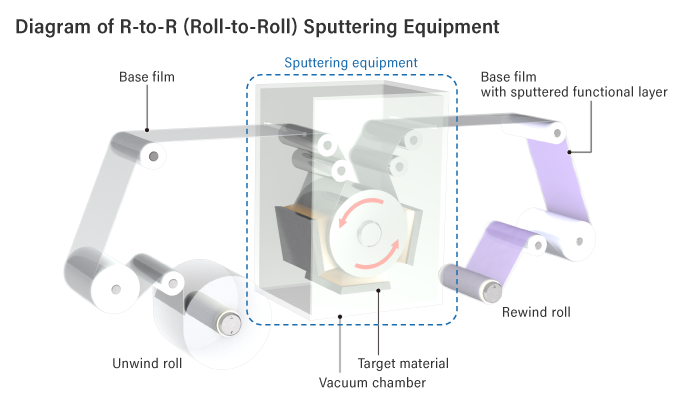
The four main features of the Dexerials’ AR film
Dexerials’ AR film offers four key benefits:
1.High Anti-Reflection Performance:
The image below illustrates, from left to right, an untreated film, a Wet-AR film, and a Dry-AR film. While the reflectance values of the first two are 4% and 1% respectively, Dexerials’ Dry-AR film achieves a reflectance of just 0.4%. This low reflectivity enhances the visibility of displays and other objects.

2.Superior Anti-Smudge Function:
Dexerials’ AR film surface features an anti-smudge layer composed of fluorine resin. This layer facilitates the easy removal of fingerprints and other stains. The images below depict Dexerials’ AR film with fingerprints, before (left) and after wiping (right).
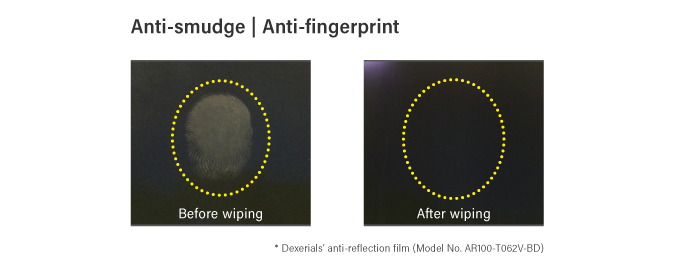
3.Excellent Scratch Resistance:
As AR films are laminated onto the device surface, it’s crucial for the film, particularly the AR layer, to resist physical forces such as wiping or rubbing. Dexerials’ sputtered AR layer, made of inorganic materials, offers superior scratch resistance compared to wet coating materials. The image below shows the result of a scratch resistance test with AR film made by the wet method (left) and by the dry method (middle). Despite identical testing conditions (right image), visible scratches are present on the wet AR film but absent on the dry AR film.
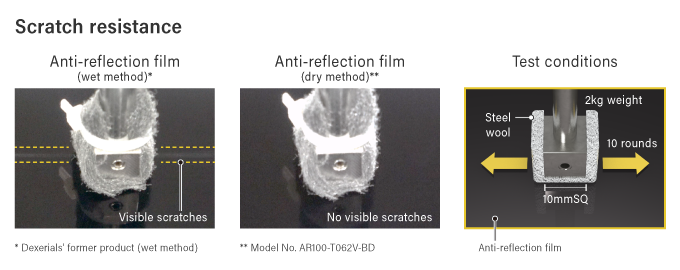
4.Anti-Shattering Function:
When AR film is applied to the surface of glass or plastic substrates, it prevents shattering. This is particularly beneficial in automotive display applications, where AR film technology can effectively prevent injuries caused by shattered glass or plastic debris.

The above details explain the workings, manufacturing process, and advantages of Dexerials’ AR film. Currently, Dexerials’ anti-reflection films are capable of minimizing the reflection of visible light. However, Dexerials envisions the potential of this technology to control not only visible light but also a broader range of light wavelengths, including ultraviolet and infrared. Dexerials remains committed to exploring new possibilities in the future.
- SHARE
 Back to top
Back to top  Contact us
Contact us 











